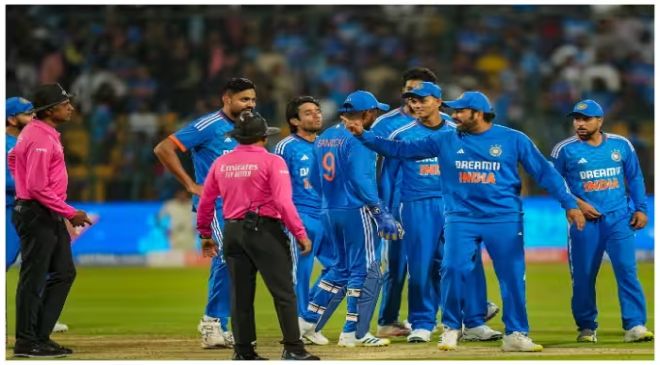For the first time in history, the cricketing world witnessed a Double Super Over at the international level.
Bengaluru: India and Afghanistan etched their named in cricket history books after their thrilling Double Super Over finish on Wednesday at the M Chinnaswamy Stadium. If Rohit ‘Hitman’ Sharma’s fifth T20I hundred and Rinku Singh’s blazing fifty were the highlights of the first innings, knocks from Rahmanullah Gurbaz, Ibrahim Zadran, Gulbadin Naib and Mohammad Nabi lit up the Afghanistan innings. Despite being a dead rubber, neither team gave up with both scoring 212 and 16 (in Super Over) each.
As a result, a second Super Over had to be played and following a controversial turn of events, the hosts managed to go home with 3-0 scoreline against a spirited Afghanistan. We all know about the infamous boundary count rule (in case of a tied Super Over) that headlined the 2019 ODI World Cup final at Lord’s but that has been done away by the International Cricket Council.
There are several rules of a Double Super Over that many of us aren’t familiar with. Don’t worry, we have got you covered. Let’s start from basics.
Read More: Australian Open: Sumit Nagal Shocks World No. 27 Alexander Bublik in Straight Sets
What Is A Super Over?
A Super Over in cricket takes place when both the teams are tied at the end of a either 50 overs (ODI) or 20 overs (T20I). Btw, Super Overs are not valid in case of Test matches. In a Super Over, both teams six balls each with two wickets in hand. The team which scores the most win the game.
What Is A Double Super Over? What If It Gets Tied Too?
A second Super Over takes place if the first one ends in a tie, like the way it happened during the third T20I between India and Afghanistan on Wednesday. If the second Super also ends in a tie, a third will be played and it continues till the winner is decided. For the unknown, the basic rule of six balls and two wickets doesn’t change no matter how many Super Overs are played in a match. So far, the world is yet to witness a Triple Super Over.
Now here comes the twist in tale.
Read More: ‘I Should Be Selected’: Mohammed Shami Speaks On Inclusion In India Squad For T20 World Cup 2024
Same Bowler Can’t Bowl In 2nd Super Over
The same bowler can’t bowl in the second Super over. That’s why we didn’t see neither Mukesh Kumar nor Azmatullah Omarzai bowl in the second Super Over. Fareed Ahmed bowled for Afghanistan while Ravi Bishnoi took up the responsibility for India.
What About Batting Switch?
In terms of batting, the team who batted first in the match has to bat second in the Super Over. The same rule applies for the second Super Over as well. To make it easy for everyone, no side can bat back-to-back or chase in 1) match-Super Over and 2) Super Over-Super Over.
Read More: Rohit Sharma Breaks Two Virat Kohli Records With Historic 5th T20I Century; Here’s Full List
Do Batters Get Advantage Over Bowlers In 2nd Super Over?
Batters have always somewhere got a bit of advantage in cricket as compared to bowlers. Unlike a bowler who can’t bowl in the second Super Over, for batters the rule is different. Based on MCC laws, a batter who was dismissed in the first Super Over is not eligible to bat in the second. But if he/she is on the list of batters and didn’t bat or wasn’t dismissed in the first Super Over, can bat in the second Super Over. In case the batter is Retired Hurt, he/she is still eligible to bat in the second. But if the batter is Retired Out in the first Super Over, he can’t bat in the second.
Was Rohit Sharma Correct In Batting In Both Super Overs?
It’s a matter of debate. According to laws of cricket, Rohit Sharma is not eligible to bat in the second Super Over since he retired himself out to let Rinku Singh in as he can run faster than him. If Rohit was Retired Hurt in the first Super Over, he was within the rules to bat in the second. However, ICC is still give a word on the matter.



































